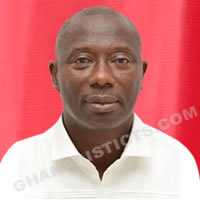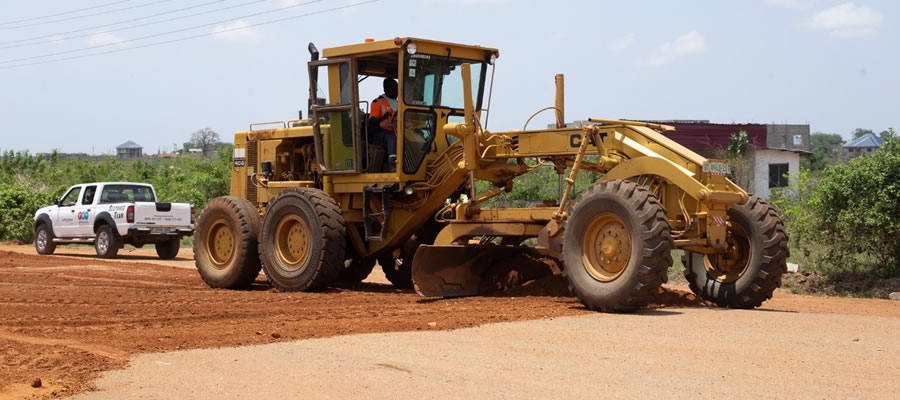

Political Structure of the Assembly (Local Government Structure)
Decentralization has been a major policy agenda of government since 1992. In pursuit of this agenda, various governments guided by the philosophy of the rule of Law and good governance, created additional Districts and also elevated some districts to municipal and metropolitan status. The creation of the Kpone Katamanso Municipal Assembly from the Tema Metropolitan Assembly inevitably changed the geographical and socio-economic characteristics of the latter in terms of re-demarcation of boundaries and sharing of assets among the two Assemblies. The implementation of development projects, plans and programmes therefore took cognizance of this development.
Resource mobilization from both internal and external sources, capacity building programmes and poverty reduction interventions from government and development partners such as the District Development Fund (DDF) and Non-Governmental Organizations within the framework of the Ghana Shared Growth and Development Agenda II (GSGDA II) contributed in no small measure in pushing forward the Development of the newly created Municipality
Development in the decentralization front has necessitated the embracement of the Local Government Service which seeks to operationalize the decentralized departments at the district level. The decentralized organizational layout of the Kpone Katamanso Municipal Assembly gives a reflection of the Assembly’s core values towards the realization of its objectives. The prototype organizational chart captured depicts the working relationship with various units, decentralized departments and agencies.
The Local Government Act 936 2016 and Local Government Legislative Instrument LI 2031, established the Kpone Katamanso Municipal Assembly (KKMA) on the 28th day of June 2012 and commenced business on 4th July 2012 under the decentralization system to take control of the day-to-day running of the Municipality. KKMA was empowered by the law with deliberative, executive and legislative responsibilities. The Assembly was tasked to make laws, including the rules and byelaws which give legal effect to decisions and also mobilize resources to undertake developmental programmes and activities.
The structure of the Kpone Katamanso Municipal Assembly has a 3-tier structure made up of the Municipal Assembly, Zonal Councils and Unit Committees. The Assembly has a membership of 29 made up as follows: (18 elected, 9 appointed, 1 Member of Parliament and 1 Municipal Chief Executive).
The Assembly members are elected every four years through the Universal Adult Suffrage. These members are expected to keep close contact with their electoral area, consult their people on issues discussed at the Assembly and collate their views and opinions and present to the Assembly. However, inadequate revenue mobilization makes it difficult for the Assembly members to carry out this responsibility. As a result of this, there is absence of grass root participation in local governance at the metropolis. This has resulted in lack of community acceptance and ownership of projects thus making these projects not sustainable. The Assembly members elect one representative from among them to serve as the Presiding Member who presides over the General Assembly meetings. The Presiding Member is elected once every two years and is eligible to stand for re-elections.
Administrative structure of the Assembly
Administratively, the Chief Executive is responsible for the day-to-day performance of the Executive functions of the Assembly. He also supervises the various departments in the Assembly and is the chief representative of the Central Government in the Municipality. After the Chief Executive, is the Municipal Co-ordinating Director who is a civil Servant and the Secretary to the General Assembly? The Co-ordinating Director performs administrative functions in the Assembly and reports directly to the Chief executive. The various departmental heads and agencies also report to the Director.
In the Assembly, policy decisions are decided by the General Assembly and then implemented by the Executive Committee. The committee exercises executive and coordinating functions of the Assembly. The committee is composed of not more than 1/3 of the total membership of the General Assembly and is chaired by the Chief executive.
The Executive Committee co-ordinate plans and programmes of the sub-Committees and submits them as comprehensive plans of action to the Assembly. The committee is in charge of implementing resolutions of the Assembly and oversees the administration of the Assembly in collaboration with the office of the Chief Executive, among others.
The Executive Committee has the following Sub-Committees:
a) Development Planning Sub-Committee
b) Social Services Sub-Committee
c) Works Sub-Committee
d) Justice and Security Sub-Committee
e) Finance & Administration Sub-Committee
f) Revenue Mobilization Sub-Committee
The Sub-Committees are responsible for collating and deliberating on issues relevant to the Assembly in its deliberative, executive and legislative function. They submit their recommendations to the Executive Committee for consideration, which are later ratified by the General Assembly.
The Assembly also has other committees apart from the ones stated in the local government Act 936. The committees are Tender, the HIV/Aids committee, the Municipal Implementation Committee of the Ghana School Feeding Programme, Education Sub-Committee, Statutory Planning Sub-Committee, Agric Sub-Committee and a Public Relations and Complaints Committee. Public Relations and Complaints chaired by the Presiding Member receives complaints made against the conduct of Assembly members and staff from the public and makes recommendations to the Assembly.
As part of its effort to bring governance to the grassroots and ensuring social accountability, the Assembly organizes quarterly General Assembly meetings, periodic community durbars, Town Hall meetings and public hearings. This creates the platform to engage the citizens and allow for grassroots participation and ownership of all decisions made. The Assembly engages the public in the preparation of its Medium Term Plan, Fee fixing resolution and Budget.
Annual Financial Statements and Audit reports are pasted on public notice boards for everybody to access as means of ensuring Accountability and Transparency. Information vans with public addressing system frequently patrol the communities to disseminate information at the doorstep of the people. There is effective stakeholder consultation in dealing with issues. The Traditional authorities are engaged in decision making at all levels of decision making.
Sub Structures
Area/Town Council
There are four (4) area councils and 18 Unit Committees in the Assembly. The four Zonal Councils are Kpone, ZEKAS, KAMSBERG and ONSBAC. Members of the Area councils are drawn from the elected members of the Assembly, members from the various Unit Committees under the Council and some residents appointed by the Municipal Chief Executive on behalf of the President.
The Area councils are responsible for collecting revenue, implementing bye-laws and performs oversight responsibility of community-initiated projects, among others in their areas. These Area councils have been inaugurated and are operational. However, these Area councils are faced with logistical constraints and inadequate funds for them to operate its full capacity. The table below portrays the Zonal Councils and its respective communities.
Traditional Authority
The Traditional authority in the Municipality is embedded in the chieftaincy institution. The authority continues to play a pivotal role in the current governance system in the Municipality. There is one main traditional authority in the Municipality namely the Kpone Traditional Council with its seat of governance in the Municipality capital, Kpone and also exist are some divisional councils who pay allegiance to the Kpone, Nungua and Tema Traditional Councils respectively. The traditional council and other chiefs from the various communities are represented in the General Assembly and are very active in the Assembly’s
activities.
Over the years these traditional authorities have contributed immensely to the development of the Assembly. They encourage their people to get involved in all of the Assembly’s activities. They also settle minor disputes in their areas of jurisdiction. This collaborative effort between the traditional authorities and the Assembly has made it easy in most cases for the Assembly to implement their plans without any confrontations with the people. They have helped in solving land litigations and chieftaincy disputes. They have also released lands for developmental purposes.
Non-Governmental Organizations (NGOs)
There are several NGOs operating in Municipality to augment the Assembly’s efforts in development and directly improving the livelihoods of the inhabitants. These are done through the provision of employable skills such as Soap making, Basketry, Wood carving, solar energy assembling, Information Technology etc. the others are into advocacy, providing support for the vulnerable, rescuing missing and abandoned children and promoting cleaning environment along the beaches. These NGOs are Gyeyen ‘Save Us’ Organization, Rose from Mama Africa International, Save them Young Mission, Rescuers Solution Centre, Home of Care and Protection, Helping Hand Medical Outreach, Lamix Foundation Ghana, Roberta O. Darko Foundation, Future Royalty Foundation, Givers Foundation, Rescue Ghana Mission and Save our Beaches Ghana. Their efforts must be commended as their activities promote development in the Municipality.
Local Economic Development (LED)
Local economic development in the Municipality is an enterprise that can be harnessed and should take advantage of it. The sector has the propensity to engender growth and create employment for the unemployed, especially, the youth. Local artisans including: upholstery, fabricators, welders, mechanics, electricians, dress makers, shoe makers, plumbers and many others are a few mentioned opportunities upon which the youth and unemployed can thrive for economic opportunities. Some of the youth enroll as apprentice, with time they are able to operate their businesses. This local enterprise, however, face dire challenges of space (land), inadequate or lack of start-up capital, limited access to credit facilities, poor business development services and competition from the formal sector. As a Municipality there is the need to develop this sector by developing and building a local content that will foster and promote indigenous economic development. The Assembly has budgeted to support these local enterprises to improve their businesses but there is still more room for improvement. A committee has also been set up to champion LED in the Municipality.
Science, Technology and Innovation (STI)
The application of science and technology can never be down played in the development of any nation and for that matter the Municipality. The application of science and technology in Agriculture, health care system, education, research, telecommunications, construction etc. affects the development of these sectors and the total development of the Municipality. The Municipal Assembly since its inception have applied the aspect of science in coming out with a cartographic map of the Municipality and other maps, increase its revenue with the purchase of a billing machine and a software to generate bills, in naming streets by the use of GIS/GPS. Additionally the use of mobile phones and computers in the Municipality are overwhelming. Per the 2010 population and housing census, 73.1 of the population owned mobile phones. The application of science and technology in general have improved the operations of the Assembly and lives of the people in the Municipality.
STI is also helping the Municipality to develop it website and this will make the Municipality more marketable both national and international. This is depicted to attract more investors that will lead to development in the Municipality.
As science and technology continues to progress, it is anticipated that, development in the Municipality will relate to it and measures will be put in place to address the adverse effects that comes with it.
Date Created : 4/27/2023 12:00:00 AM












 facebook
facebook
 twitter
twitter
 Youtube
Youtube
 +233 593 831 280
+233 593 831 280 0800 430 430
0800 430 430 GPS: GE-231-4383
GPS: GE-231-4383 info@ghanadistricts.com
info@ghanadistricts.com Box GP1044, Accra, Ghana
Box GP1044, Accra, Ghana